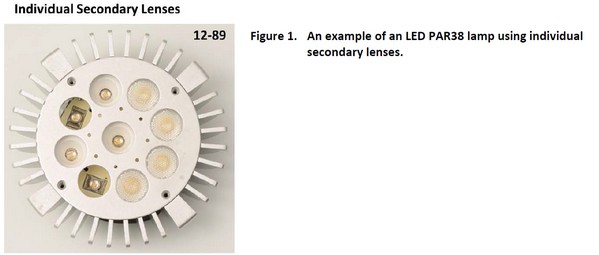The U.S. Department of Energy's CALiPER program has released Report 20.5, which is part of a series of investigations on LED PAR38 lamps. The new report builds on CALiPER Report 20.4 by providing a tear-down analysis of its 32 LED PAR38 lamp models and also performing additional analyses on the spectroradiometric data obtained using a specially developed automated long-term test apparatus. The focus of the new report is to investigate causes of color shift and parametric failures within these lamps.
In general, samples of the same PAR38 lamp model usually exhibited the same chromaticity shift behavior, and there were similarities in chromaticity shift trends between lamp models with similar LED packages. However, the timing of different chromaticity shifts varied somewhat between lamp models and appears to depend upon lamp design, characteristics of the LED packages used in the lamp model, and lamp operational conditions.
 |
|
An example of an LED PAR38 lamp using individual secondary lenses. (Photo courtesy of DOE) |
The PAR38 lamp models examined in this study exhibited a systematic chronology in chromaticity shift that depended on LED package type and operational conditions such as LED board temperature and drive current. Nearly all samples were found to initially shift in the blue direction, but subsequent shifts tended to be first in the green direction, followed by a shift in the yellow direction.
This led to the description of four different chromaticity shift modes, which provide a means to understand the chronology of chromaticity shifts in relatively simple LED lighting devices such as PAR38 lamps and may provide a convenient starting point for analyzing chromaticity shifts in more complex products.
For a closer look at the findings, download the full report.












